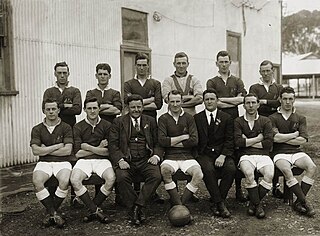
The Adelaide Oval is a sports ground in Adelaide in the state of South Australia. It is located in the parklands between the city centre and North Adelaide. The venue is predominantly used for cricket and Australian rules football, but has also played host to rugby league, rugby union, soccer, and tennis, as well as regularly being used to hold concerts.
Attila Abonyi was a soccer manager and player. Born in Hungary, he played for the Australia national team.

Reg Date was an Australian soccer player who plied his trade after the Second World War. Date played for Wallsend Football Club and Canterbury-Bankstown. He represented Australia in five full international matches, captaining three times.
Alex Gibb was an Australian soccer player who played half-back with Queensland clubs and the Queensland and Australia national teams. Gibb is recognised as Australia's first international captain, and was awarded Socceroo cap number one retrospectively in 2000 by Football Federation Australia, for Australia's first Test match against New Zealand, played in 1922.

Alfred Quill was an Australian soccer player and played for the Australia national team. Often considered one of the best soccer players in New South Wales, he scored 868 goals in all NSW competitions in his 24-year senior career.
William Coolahan was an Australian soccer player. He captained Australia in three matches.
Frank Parsons was an Australian soccer player who played as a striker for the Australia national soccer team. He played his club football for Adamstown and Leichhardt-Annandale.
William "Podge" Maunder was an Australian soccer player. Maunder is recognised as the player who scored Australia's first international goal.
Percy Lennard (1900–1975) was an Australian soccer player.
The 1932 Great Britain Lions tour was a tour by the Great Britain national rugby league team) of Australia and New Zealand which took place between May and August 1932. The tour involved a schedule of 26 games, 18 in Australia including a three-test series against Australia for the Ashes and a further eight in New Zealand including a three-test series against New Zealand.
George Smith was an Australian professional soccer player who played as a forward. He captained the Australia national soccer team in 1933. Often considered the best centre-forward in Australian soccer in the 1930s, he had an average of 2.66 goals per game for Australia and has had many goalscoring records throughout his 17-year career.
The Wales national football team is the third-oldest side in international association football. The team played their first match in March 1876, four years after Scotland and England had contested the first-ever international match. Wales played annual fixtures against Scotland, England, and later Ireland, and these were eventually organised into the British Home Championship, an annual competition between the Home Nations. Wales did not win their first championship until the 1906–07 tournament and this remained the nation's only triumph before the First World War. Wales improved considerably in the post-war period, and claimed three titles during the 1920s, although the team was often hindered by the reluctance of Football League clubs to release their players for international duty. The situation was so grave that, in the early 1930s, Wales were forced to select a team of lower league and amateur players which became known as "Keenor and the 10 unknowns", a reference to captain Fred Keenor and the relative obscurity of his teammates.
Francis Walker McIver was an Australian soccer player, coach and administrator. A prolific forward, he represented Victoria and Australia. He was an inaugural inductee into the Football Federation Australia Hall of Fame in 1999 and inducted into the Football Victoria Hall of Fame in 2016.
Alec Cameron was an Australian professional soccer player who played as a forward and captained the Australia national soccer team.
This article summarises the Australia men's national soccer team in 1923.

This article summarises the Australia men's national soccer team in 1924.
This article summarises the Australia men's national soccer team in 1933.
This article summarises the Australia men's national soccer team in 1936.



